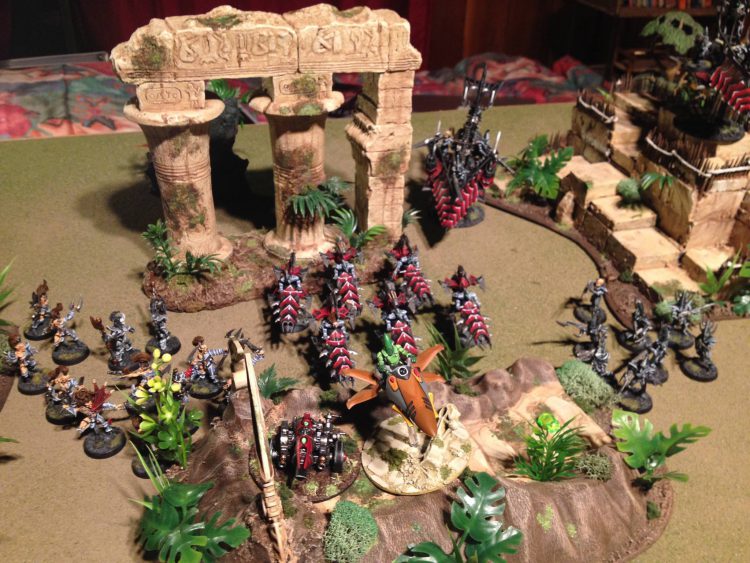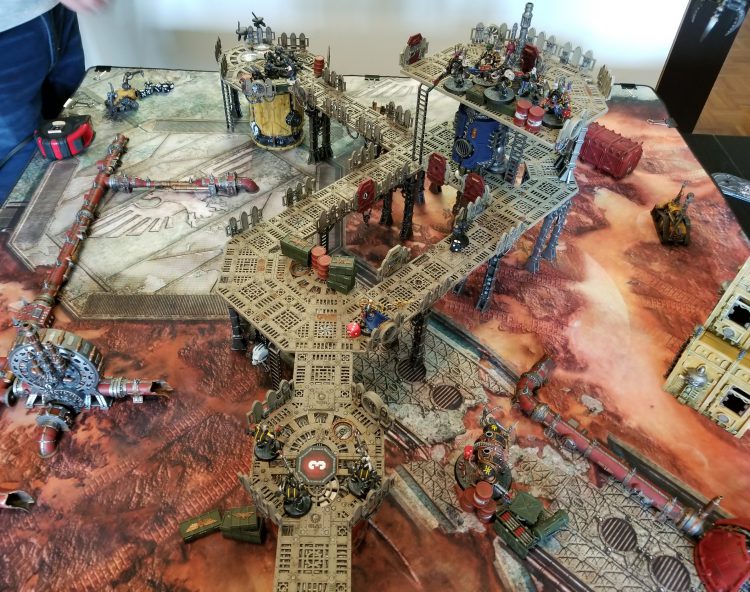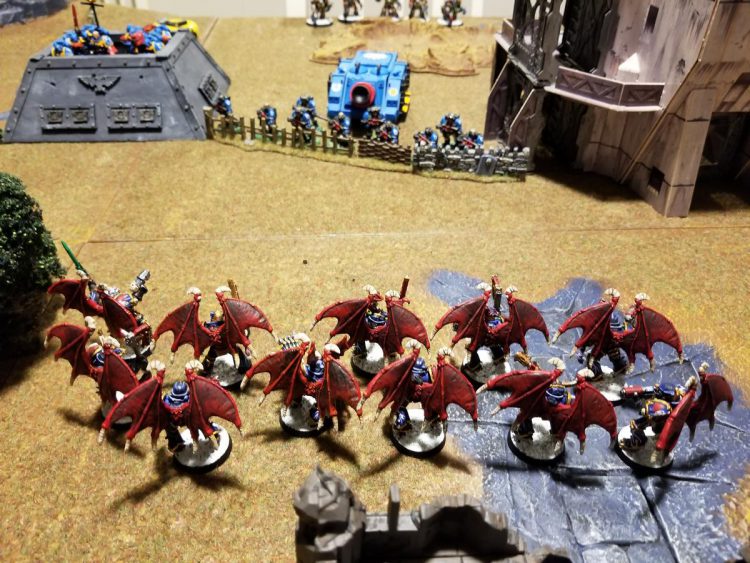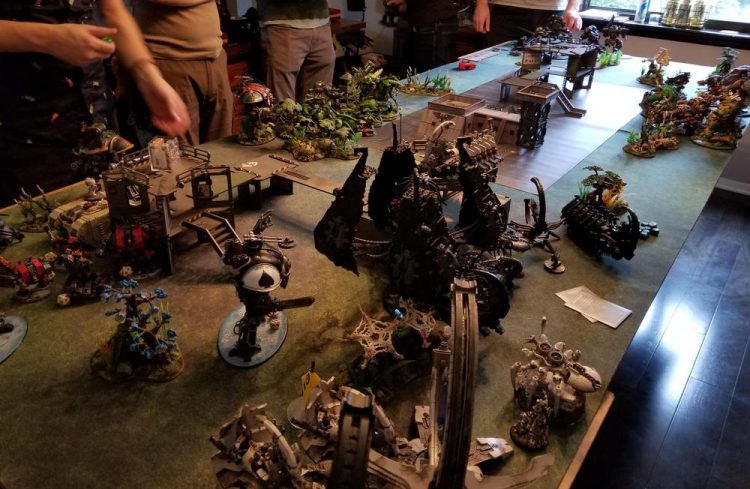In today’s Narrative Forge, Robert “TheChirurgeon” Jones and Evan “Felime” Siefring will be talking about the Missions and Agendas in Crusade, how they differ from Matched Play missions and rules, and what you need to know about playing them. We’ll take a little bit lighter touch than we do with our competitive play reviews since Crusade and Narrative play aren’t so much about crushing your enemies and seeing them driven before you as they are telling a good story.
In broad strokes, the Crusade missions are simpler mechanically – typically with only a single objective – with secondary complexity instead coming from the agendas and other methods of gaining experience. They’re also a lot more willing to be asymmetrical or otherwise delve into mechanics that are thematic, but aren’t perfectly balanced. For the most part, though, they seem to have put a lot of thought into them and they don’t favor either player.
Agendas
Agendas in Crusade missions replace the secondary objectives in standard Matched Play missions, but they’re similar in many ways. However, they award the units that accomplish them with experience instead of victory points. Along with killing units and the end of battle Marked for Greatness choice, these are the main way to quickly advance your units.
On average, most agendas will net you 4-6 experience points across your army if successful, depending on difficulty. There are some that can potentially award more, but are situational or harder to achieve to that level, and some that give less, but are either automatic or extremely easy.
When selecting agendas, you pick 1 for a Combat Patrol game, 2 for an Incursion game, 3 for a Strike Force game, and 4 for an Onslaught game. Each agenda you pick must come from a different category, forcing you to diversify your goals as your games get bigger.
Purge The Enemy
- Assassins: 2 experience for each character killed. This is potentially a really good one if your opponent rolls up with a whole load of characters. Probably slightly situational, but you can probably rely on at least getting a few experience out of this.
- Priority Target: 2 experience for each monster or vehicle killed. This is also situational, but probably ranging from decent to absurdly good. Other players in your campaign are going to hate anyone who brings full units of 3 sentinels or a flock of landspeeders and hands you 6 free XP.
- Titan Hunter: 4 experience for each titanic unit killed. Titan Hunter is much less likely to leave you overflowing with experience than the other Purge the Enemy agendas, but it’s a solid against the knight armies it is designed for.
- Kingslayer: 3 experience for the unit that kills the enemy warlord. No double dipping with resurrection abilities. I feel like this one is a bit of a swing and a miss. 3 experience isn’t a lot in comparison to other, much more reliable agendas, especially in the Purge the Enemy category.
No Mercy, No Respite
- First Strike: 1 experience for each unit killed in the first turn. Potentially good in a very large game, but I expect it won’t net you as much as a lot of the Purge the Enemy options. If you’re playing onslaught and have to pick 4 agendas, but don’t have any psykers for Warpcraft objectives, you might go with this.
- Cull the Hordes: 1 experience each time a unit kills 6 or more models in the same phase. Probably good if you run up against hordes, especially if you have blast weapons or scary, multi-phase threats like knights. Bad against MSU.
- Reaper: 2 experience to the unit that destroys the most units. Pick in case of a tie. Another stinker in my opinion. It’s automatic, but it’s only 2 experience. There are two times I could see picking this. Either you have to pick 4 objectives for an onslaught game and both warpcraft and the other No Mercy, No Respite agendas don’t look promising, or if I wanted to stack as much experience as possible on one powerful unit to ensure they level up fast. Cull the hordes is still probably better for that, though.
Battlefield Supremacy
- Sentinel: Pick a unit and an objective. If that unit is on that objective at the end of the game, it gains 4 experience. A bit dicey. This is potentially really easy for your opponent to deny just by killing that unit. Could be useful for very, very durable units.
- Breakthrough: At the end of the game, pick up to 3 units (except aircraft) wholly within 6” of your opponent’s battlefield edge. Each of them gets 2 experience. Probably a mainstay of dark eldar and other highly mobile factions that end up in the enemy deployment zone as a matter of course.
- Survivor: Pick a unit. That unit gets 2 experience if it survives the battle, and 4 experience if it’s over half strength. (Single model units get 4 experience if over half wounds.) You know how I said Sentinel was dicey because your opponent could easily deny the experience? Yeah. Maybe on a durable unit that shoots from outside of Line of Sight.

Shadow Operations
- Secure the Area: One non-character infantry unit can do an activity at the end of movement if it’s within 6” of the center of the battlefield, and finishes at the end of your turn. It gains 1 experience. Potentially a reliable source of experience if you plan on controlling the board.
- Search for Archaeotech: Any number of infantry units can do an activity after movement if they’re wholly within your opponent’s deployment zone, finishing at the end of your turn. Every unit that does this twice or more gets 3 experience. So, in theory this could give you crazy amounts of experience, but it’s infantry only. I think you’ll have trouble racking up lots of experience without throwing the game unless you have lots of deep striking MSU which don’t see too much benefit from experience or are trouncing your opponent already. You can probably net at least a few experience, though, so not too bad.
- Deploy Vox- Relays: Select one infantry unit. That unit can do an activity to set up vox-relays on an objective after movement and ending at the end of your turn. Your opponent can knock these off by controlling the objective at the end of any phase. That unit gets 2 experience for each objective that has a vox-relay on it at the end of the game. An okay agenda. Probably best if you’re planning to control the battlefield and it’s a 6 objective mission. You’re not going to get the full 12 potential experience out of this, but you should get some unless you get stomped and overrun.
- Recover Mission Archives: One infantry, cavalry, or biker unit can do an activity at the end of your movement phase to search an objective. If they’re still on that objective at the end of your next command phase, they successfully search the objective. At the end of the game, roll 1d6. If you get equal to or under the number of objectives you searched, pick a unit that searched an objective and it gains 6 experience points. (In missions with under 6 objectives, you also gain the 6 experience if you search all of the objectives.) High risk, but high reward. Together with the passive 1 experience for participating in the battle, and 3 for marked for Glory, you can potentially dump 10 experience on a unit that searched an objective in your deployment zone on the first turn then ran off to do its thing. On the other hand, you could also end up with nothing, especially if your opponent makes a point of shooting units off objectives before they can finish searching them. (Only one unit can do this action every turn, and you only have 5 battle rounds for most missions.)
Warpcraft
- Witch hunter: Units gain 1 experience for killing a psyker unit, and 3 experience for killing a psyker character. Pretty simple. Potentially quite good if there’s a lot of psykers on the field.
- Lord of the Warp: Units get a tally each time they manifest a power, deny a power, or complete a psychic action, resetting to 0 if they roll perils. The unit with the highest tally gets 2 experience, choosing if there’s a tie. 2 experience isn’t a lot, but at least it’s reliable.
- Scry Battle Plans: One unit each turn can get a tally by completing a Warp Charge 4 psychic action on an enemy character within 18”. Each unit with at least 2 tallies gets 5 experience. Much better. You’re giving up powers or smites, but 5 experience is a lot. You do need to be in the thick of it to achieve this, but you can probably count on getting at least one unit that 5 juicy experience.

The Missions
Similar to Matched Play, Crusade provides missions for four different levels of play: Combat Patrol, Incursion, Strike Force, and Onslaught, with each being designed for games of a different size. Unlike the Eternal War and GT missions, missions in Crusade may have extra rewards for players that affect their campaign forces. As we mentioned earlier, these tend to be a bit more asymmetrical than Eternal War missions, and have actual differences for the Attacker and Defender.
Rules Differences from Matched Play
There are a few things to note about the rules for Crusade Missions that differ from those in Matched Play:
- Because you can have multiple characters with Warlord Traits in Crusade, your actual Warlord in a Crusade game is the CHARACTER in your army with the highest Leadership characteristic. If your army has a tie, you can pick one, and it gains the WARLORD keyword.
- Technically, Crusade games do not fall under Matched Play, and so Matched Play rules like requiring players to pay reinforcement points for summoned daemons do not apply to Crusade games. This is, on the whole, not great and we recommend you use Matched Play rules in your Crusade games.
- As we mentioned earlier, Crusade Missions do not have Secondary Objectives, but instead give players Agendas, which reward players with XP. This has fairly broad implications for the missions and balance, which we’ll talk about later.
- Players can score a maximum of 90 Victory Points from mission objectives, plus 10 more for having a fully-painted army. Unlike in Matched Play, these all come from Primary Objectives and there’s no per-turn cap unless the mission specifies it.
- Crusade Missions have a long post-game process where campaign cards are updated, Out of Action tests are taken, and Experience Points are tallied.
Combat Patrol
Armies in Combat Patrol missions max out at a combined Power Level of 25 and each player starts with 3 Command Points. In addition, a Combat Patrol army can only include a single Patrol Detachment unless your faction is Imperial Knights or Chaos Knights, in which case you can only include one Super Heavy Detachment.
There are three Combat Patrol Missions, and of these Assassinate is the only one that’s really Asymmetrical.
- Sweep and Clear sees two patrols coming across each other and rushing to wipe the other out before they can gain a foothold for their larger army. This mission has four objective markers placed by players; one in each player’s deployment zone (the mission uses a Hammer-and-Anvil style longways deployment map), and two in the “Centre ground,” a 6-inch band in the middle of the battlefield. Objectives in this mission stay held after they’re captured until an opponent controls them, allowing armies to range a bit, and the mission uses progressive scoring. The winner gets to mark two units for greatness instead of one after the battle.
- Supply Drop is about two armies rushing to grab supplies dropped in no man’s land, trying to secure drop zones for where the final supply drop will happen. As the game goes on, objectives are randomly removed from the battlefield and held objectives are worth progressively more points. The winner of the game gets 2 RP after the battle instead of 1.
- In Assassinate, the Attacker’s forces have been tasked with taking out the Defender’s Warlord. The Defender’s Warlord has to be set up in a specific area on the table and can’t go into Strategic Reserves or Deep Strike. If the Defender’s Warlord has fewer than 10 wounds, they gain the ability to ignore lost wounds on a 6+. The Attacker always gets first turn, and their goal is to kill the Defender’s warlord. They score VP for wounding or killing the enemy warlord, and the Defender scores points for keeping their Warlord alive. The winner gets to give a unit in their army a free Battle Trait of their choice.
Rob: Of these, Assassinate is the most interesting, with progressive and endgame objectives around damaging the Warlord, and while I’d have liked to see the reward tied to interacting with the Warlord in some way, that would have been tough to work out for the Defender.

Incursion
There are six Incursion missions, and it’s clear that while Crusade starts at Combat Patrol size, it’s clear that Incursion and Strike Force are the real meat of how GW expects Crusade to be played.
- Supply Cache is a symmetrical mission that sees two armies hunting for supplies in no man’s land is about as generic as missions come. Dawn of War style deployment, 4 objectives placed by players, and progressive scoring for holding one/one in an opponent’s deployment zone/controlling more. The winner gets 2 RP instead of 1.
- The Relic is a translation of the 8th edition mission of the same name, in which two armies fight over a relic placed in the middle of the table. Infantry units can pick up the Relic and move with it around and points are scored for holding the relic and ending the game with it. We also finally have a thematic reward: The winner of this mission gets to give one Crusade Relic to a CHARACTER in their army who took part in the battle.
- Sabotage is an asymmetrical mission in which the Defender drops four objective markers on the table that the Attacker is attempting to Sabotage via the Sabotage action. The Attacker gets first turn and scores points for destroying the objective markers, while the Defender scores for keeping them around. If the Attacker wins, they get to give one unit in their army a Battle Honour of their choice. If the Defender wins they get a free Resupply and Rearm action.
- Recon is a symmetrical mission that sees two recon forces meeting by chance and calling for reinforcements in a translation of the 8th edition “Patrol” mission. Both players have to keep at least half (and no more than three quarters) of their units into Strategic Reserves at no CP cost before the game starts, and when these units can arrive on the first and second battle rounds if they pass a Reserve test, which is a 4+ on a D6. Players score points for holding objectives and performing the Recon Sweep action in each table quarter. The winner gets to Mark two units for Greatness after the battle.
- The Ritual is an asymmetrical mission in which the Defender is trying to complete a ritual in a specific circular area of their Deployment Zone, in which the Defender’s Warlord must be set up (the Warlord gets a 4+ invulnerable save while wholly within this circle). The Defender can score points for performing rites in the circle – there’s both a psychic action and a regular action for this – and both players can score points for holding objectives, plus the Attacker can score points for killing the enemy Warlord. This mission has asymmetrical rewards – the Defender can give their Warlord a Battle Trait (or a Psychic Fortitude if they’re a PSYKER), while the Attacker can give a unit a Battle Honour of your choice.
- Behind Enemy Lines is a Symmetrical mission which the armies are attempting to infiltrate deep behind enemy lines at night, on a battlefield riddled with scramblers. Units can’t deploy outside their deployment zones and can’t be set up elsewhere, and when shooting at units more than 18” away, units get -1 to their To Hit rolls. Players can score for getting units off the opposite table edge with the Exfiltration Action, and players score for Linebreaker, completing the Exfiltration Action, and keeping opponents from exfiltrating. The winner can give a battle Trait of their choice to a unit that exfiltrated successfully.
Evan: The incursion missions look quite interesting. I’m torn on The Ritual. On one hand it’s an interesting asymmetrical mission(and I think it’s a good base to build your own similar missions), but on the other, your warlord, who you presumably took because you wanted to do cool things with them, has to do nothing for most of the battle unless they’re a Psyker. I expect imperial armies will be including an inquisitor in their roster who is mysteriously their warlord for this mission. Knights players just cry or accept the loss and play for experience. It might be possible to run a super-heavy detachment of all armigers and an auxiliary detachment with a psyker at the cost of most of your Command Points.
Rob: I think the Ritual is neat but yeah, it’s kind of dumb if you don’t have a Psyker. For me The Relic and Sabotage are the missions I’m most excited to play – they just have more interesting things going on with them design-wise.
Strike Force
There are six Strike Force missions, four symmetrical, two asymmetrical.
- Supplies from Above sees armies going after supplies being air-dropped onto the battlefield, and objective markers move as they’re carried by the wind each battle round. Players score for holding objectives, and the winner gets 2 RP instead of 1.
- Narrow the Search is a translation of the 8th edition mission of the same name, where armies are investigating an area in the center of the table that prevents units from taking Invulnerable saving throws. Players score points for holding objectives and controlling the area in the middle of the battlefield.
- Cut off the Head is a really cool symmetrical mission that revolves around each army’s characters holding vital intelligence. At the start of each player’s first Command phase they have to allocate 30 Intel points as evenly as possible across CHARACTERs in their army. These Characters can perform the Transmit Intel action, and keeping these characters alive and killing the ones in your opponent’s army are the key to scoring points in this mission. The winner can give a CHARACTER that had intel points in their army a Warlord Trait for free.
- Retrieval is an asymmetrical mission where the Defender is attempting to rescue a courier stranded and wounded behind enemy lines while the Attacker is attempting to locate and kill the same courier. Six objective markers are placed and players can search them with the Search Site action, rolling to see if that objective marker is the courier’s location (the marker is removed if the courier is not at that location). Players score points for securing the Courier. If the Attacker wins, they can give a Character in their army a Crusade Relic, and if the Defender wins they can add a new Character to their order of battle with a free Warlord Trait, Relic, or Specialist Requisition (this represents the courier being added to their army).
- Raze and Ruin is a symmetrical mission that has both sides fighting over objective markers, but in a fun twist, players can destroy markers belonging to their opponent. Points are awarded for controlling markers and for destroying them. The winner gets to use the Increase Supply Limit Requisition free, twice (this adds 10 PL or about 200 points to their Order of Battle).
- Ambush is an asymmetrical mission that sees an Attacker ambushing the Defender in a pincer strike. The Defender deploys along the long center line of the table and there’s a cool mechanic here where the Attacker gets to choose whether to press the Attack, in which case half their army has to start in Strategic Reserves at no CP cost and these units can’t arrive until turn 3. If they instead choose to wait for further forces, they can make choices as normal. This is important because the Attacker gets the first turn if they Press the Attack and go second if they wait for further forces. The Defender can’t set up any units in reserves, and neither army can add units mid-battle or merge units together. Players score by killing enemy units and the enemy warlord. The winner can give a unit in their army a Battle Trait of their choice.
Rob: Overall, these are alright. The most interesting of them is Cut Off the Head, and I think that the design space it creates is worth exploring in more detail. Retrieval is also pretty great and the asymmetrical rewards for winning are great. I love the idea of using this mission as a way to get weird allies into campaign armies.
Onslaught
There are three Onslaught missions, for the really big games that are largely going to be occurring well into your Crusade. If you’re familiar with the Apocalypse missions from 8th edition, then these will be familiar.
- Firestorm is a symmetrical mission that sees players fighting over a battlefield wracked with artillery fire and orbital bombardment. This mission has no objective markers and players score victory points for killing enemy units. The winner gets 2 RP instead of 1.
- Grand Assault is an asymmetrical mission that uses 8 objective markers placed by the Defender. Their job is to defend these while the Attacker attempts to plant a banner on them (via an Action). The Attacker gets the benefit of Sustained Assault rules, allowing them to bring back destroyed units and remove damaged ones in order to replace them. Players score points for controlling victory points. The winner gets to give one of their units a Battle Trait of their choice.
- Field of Glory is a relatively straightforward symmetrical mission where players fight over 8 objective markers with progressive points scoring for holding objectives and can score extra points for having their Warlord within Engagement Range of enemy units at the end of their turns. The winner gets to give a Battle Honour of their choice to their Warlord.
Rob: Overall these work but I’m not blown away by any of them. If you didn’t think Warhammer 40k really worked for big games, these likely wouldn’t do much to change your mind. I might honestly just move to Apocalypse at this point, but that’s gonna take more conversion work. Maybe worth doing in the future.
Final Thoughts
The Crusade missions are pretty cool, and do a good job of giving players lots of options at each level. There’s definitely a lot of room to grow from here, and we’re excited to see where they go when they start converting more 8th edition missions to Crusade format. In particular, the planetstrike, stronghold assault, and cities of death rules could all use an overhaul and there have got to be better ways to incorporate battlezones.
As always, if you have any questions or feedback, drop us a note in the comments below or email us at contact@goonhammer.com. Or if you’re Patron, hop on the Goonhammer discord and give us a shout.



